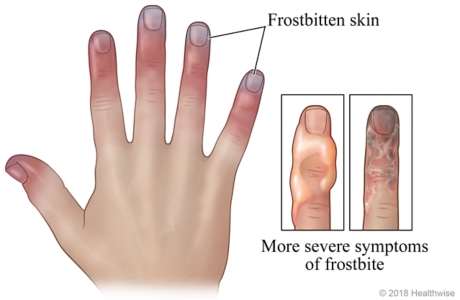Frostbite
Frostbite is freezing of the skin and tissues below the skin. It occurs when a person is exposed to freezing temperatures [ 32°F (0°C) ] or lower for too long.
How severe the frostbite is depends on how long the person was exposed to cold, the temperature, the windchill, and the humidity. Frostbite is most likely to occur on the feet, hands, ears, nose, and face. Men may have frostbite of the genitals if they do not dress properly.
Doctors rate frostbite by degree of severity:
First-degree frostbite
First-degree frostbite freezes part of the outer layer of skin. Symptoms include:
- Tingling, stinging, or burning pain.
- Red skin or, less often, white, yellow, or pink-blue skin.
- Mild swelling.
- No blisters.
Second-degree frostbite
Second-degree frostbite is freezing of all layers of the skin. Symptoms include:
- Numbness followed by aching and throbbing pain.
- Hard and frozen outer skin.
- Blisters filled with clear or milky fluid. Blisters form within 6 to 24 hours.
- Red, swollen skin around blisters.
Third-degree frostbite
Third-degree frostbite is freezing of deep layers of skin and tissues below the skin. Symptoms include:
- White, pink-purple, or blue-gray skin.
- Hard and frozen skin that "feels like a block of wood."
- Blisters that look like they are filled with blood.
- Numbness followed by burning, throbbing, or shooting pain.
Fourth-degree frostbite
Fourth-degree frostbite is freezing of muscles, tendons, and bones. Symptoms include:
- Patches of red or blue skin that turn dry, black, rubbery.
- Little or no swelling.
- Blisters that may appear as small blood spots under the skin.
- Deep, aching joint pain.
Pain may be severe as the frostbitten skin rewarms. Swelling and blisters are common after rewarming.
Medical treatment for frostbite includes relieving pain and quickly rewarming the frostbitten area. This can help prevent problems such as infection, dead tissue, or amputation of the frozen part.
Frostbitten skin

Frostbite is more likely to affect the ring finger, pinky finger, tips of the fingers, and outside of the hand, which are harder to keep warm. Frostbite will cause the skin to turn white or blue. In more severe cases, pus-filled blisters may form or the skin may turn black.
How can you care for frostbite?
- If your doctor prescribed antibiotics, take them as directed. Do not stop taking them just because you feel better. You need to take the full course of antibiotics.
- Take pain medicines exactly as directed.
- If the doctor gave you a prescription medicine for pain, take it as prescribed.
- If you are not taking a prescription pain medicine, take an over-the-counter medicine, such as ibuprofen (Advil, Motrin) or naproxen (Aleve), to reduce pain and swelling. Read and follow all instructions on the label.
- Do not take two or more pain medicines at the same time unless the doctor told you to.
- Protect skin that has been injured by frostbite.
- Do not expose frostbitten skin to cold temperatures.
- Sunscreen and protective clothing can protect frostbitten skin from damage by the sun.
- Do not rub or massage the injured area.
- Do not disturb blisters or other sores.
- Apply aloe vera to your skin as directed by your doctor.
- Do not smoke. Smoking can interfere with healing. If you need help quitting, talk to your doctor about stop-smoking programs and medicines. These can increase your chances of quitting for good.
- Avoid alcohol. It can slow recovery.
Frostbite in children: When to call
Call your doctor now or seek immediate medical care if:
- Any injured body part is cool or pale or changes color.
- Your child's pain gets worse.
- Your child has signs of infection, such as:
- Increased pain, swelling, warmth, or redness.
- Red streaks leading from the area.
- A fever.
Watch closely for changes in your child's health, and be sure to contact your doctor if:
- Your child does not get better as expected.
©2011-2025 Healthwise, Incorporated
